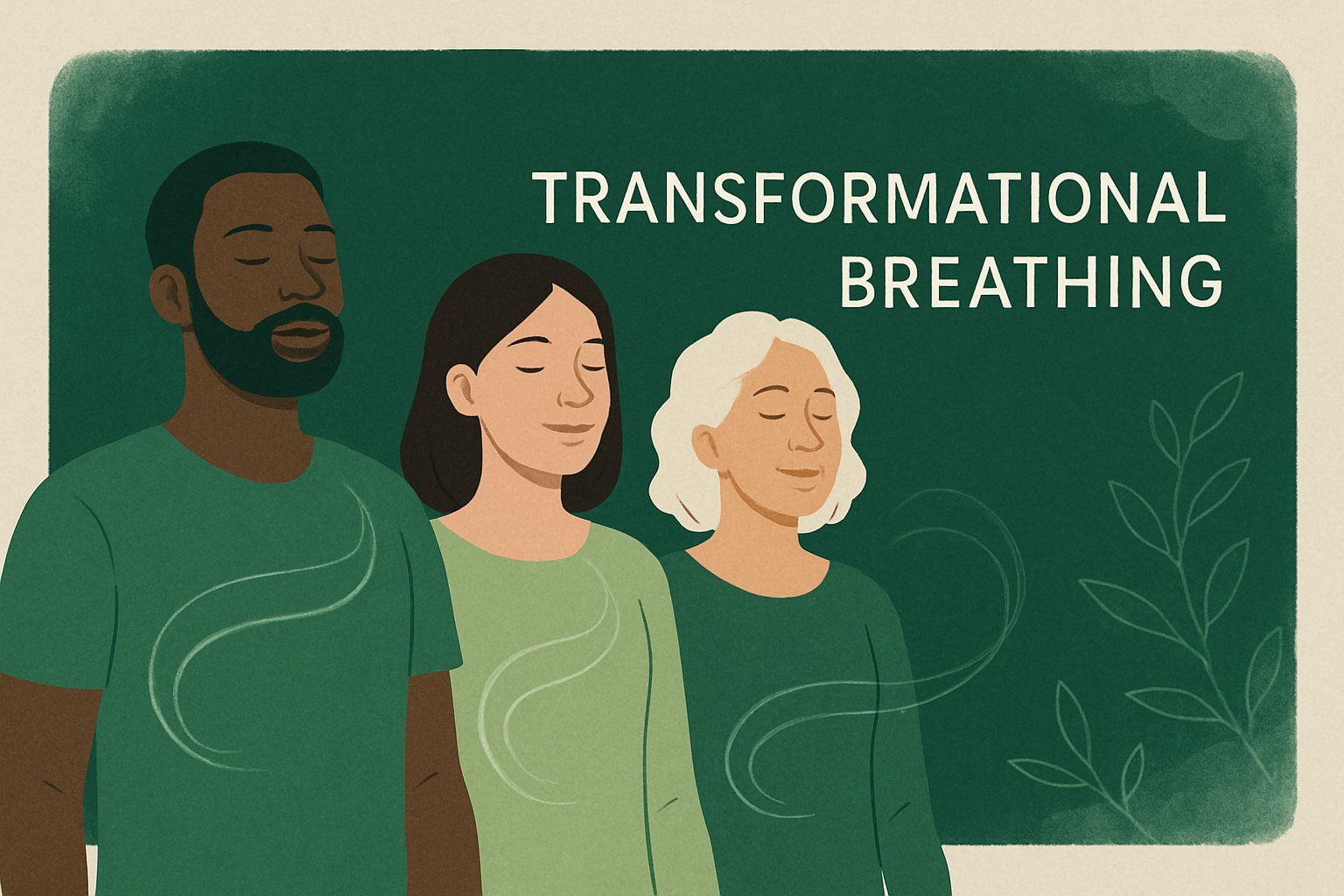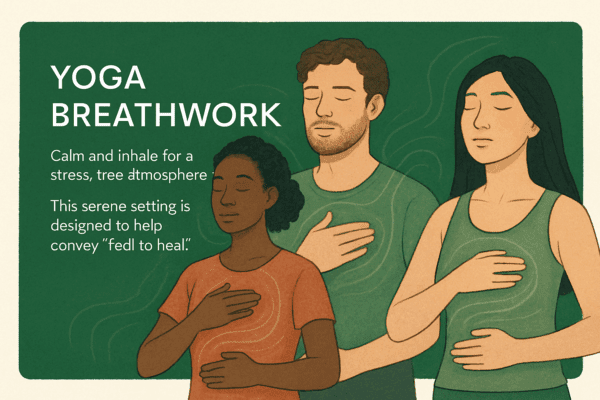Unlock the power of your breath with transformational breathing to create positive change in your mind, body, and spirit for 2025.
This guide takes you on a journey through transformational breathing—a conscious breathwork technique designed to support healing, personal growth, and overall well-being.
Curious about how your breath can become your most powerful tool? Here’s what you’ll discover:
- What transformational breathing is and its core methods
- Step-by-step practice for daily life
- Science-backed benefits for physical and emotional health
- Practical tips to integrate breathwork into your routine
Ready to reduce stress, release the past, and boost your vitality? Keep reading for a comprehensive guide that blends modern science with ancient wisdom.
What Is Transformational Breathing?
Unlocking the potential of your breath starts with understanding how transformational breathing works. This powerful practice draws on ancient wisdom and modern science to create lasting change in mind, body, and spirit.
Definition and Core Principles
Transformational breathing is a conscious, connected breathwork technique designed to activate your full respiratory system and promote holistic healing. The practice uses diaphragmatic breathing—focusing on deep, full breaths that engage the belly, chest, and lungs. This approach fosters self-awareness, emotional release, and greater vitality.
Unlike other breathwork styles, transformational breathing emphasizes three core principles: rhythm, intention, and presence. Sessions encourage a steady, flowing breath without pauses between inhale and exhale, helping you access deeper layers of physical and emotional well-being. For a deeper dive into its essential foundations, see this overview of Transformational Breath® principles and benefits.
Historical Roots and Evolution
The roots of transformational breathing reach back to ancient yogic and shamanic traditions, where conscious breath was viewed as a bridge between body and spirit. In the late 20th century, pioneers like Judith Kravitz and Leonard Orr developed the modern method, blending Eastern wisdom with Western therapeutic techniques.
Over time, transformational breathing has evolved to include insights from psychology, neuroscience, and holistic health. Its growing popularity is fueled by both scientific research and the global wellness movement, making it accessible to people from all walks of life.
How Transformational Breathing Works
At its core, transformational breathing increases oxygenation and energy flow throughout the body. The technique uses a continuous, connected breath pattern—meaning there are no pauses between inhaling and exhaling. This circular rhythm helps release physical tension and emotional blockages stored in the body.
A key aspect of transformational breathing is its impact on the nervous system. By engaging the diaphragm and maintaining a steady rhythm, you help balance the sympathetic (fight-or-flight) and parasympathetic (rest-and-digest) branches, supporting relaxation and resilience. Guided sessions, such as those found in altered state shamanic breathwork, often lead to profound emotional and physical shifts.
Who Can Benefit
Transformational breathing is suitable for people of all ages and backgrounds. It’s especially helpful if you’re seeking stress relief, trauma healing, or personal growth. Many individuals report reduced anxiety, greater energy, and a renewed sense of purpose after consistent practice.
Testimonies from meditation platforms and retreat participants highlight the accessibility and transformative power of this breathwork. Whether you’re new to breathwork or a seasoned practitioner, transformational breathing offers a supportive path for deep healing and self-discovery.
Core Techniques of Transformational Breathing
Unlocking the full potential of transformational breathing starts with mastering its core techniques. Each method is designed to help you access deeper states of awareness, release emotional tension, and foster holistic well-being. Let’s explore how these practices work together to create lasting transformation.
The Three-Stage Breath
The Three-Stage Breath is a foundational technique in transformational breathing. It involves a conscious, stepwise expansion of the belly, then the chest, followed by a full exhale. This sequence encourages full engagement of the diaphragm and activates the entire respiratory system.
To practice, begin by inhaling deeply into your belly, feeling it rise. Next, draw the breath upward into your chest, expanding your ribcage. Finally, exhale smoothly, letting go of tension. Good posture—lying down or sitting upright—ensures optimal breath flow.
Many guided transformational breathing meditations use this pattern to help you access deeper states of relaxation and clarity. Practicing regularly allows your breath to become more open, rhythmic, and natural.
Conscious Connected Breathing
Conscious connected breathing is at the heart of transformational breathing. This approach uses a seamless, circular breath—no pauses between inhale and exhale. The continuous flow helps bypass habitual tension and unlocks stuck emotional energy.
Intentional focus on each breath cycle cultivates mindfulness and presence. As you maintain this connected rhythm, the mind quiets and the body shifts into a state of openness. Over time, this technique can break old patterns and foster a sense of deep inner peace.
Practicing conscious connected breathing with intention transforms ordinary breath into a powerful tool for growth and healing.
Sound and Movement Integration
Sound and gentle movement are powerful enhancers within transformational breathing. Vocalizations—such as sighing, toning, or humming—help release emotional blockages and deepen the breath. Adding body movement, like gentle rocking or tapping, supports the release of tension stored in muscles.
These elements work synergistically, amplifying the effects of your breathwork. For example, some practices encourage participants to vocalize on the exhale or gently tap along the sternum. This integration accelerates the body’s natural healing response.
For a deeper dive, explore how sound and movement techniques enhance breathwork and support emotional release during transformational breathing.
Breath Holds and Super Ventilation
In transformational breathing, breath holds and super ventilation are used to access altered states and support emotional catharsis. Breath holds involve pausing after an inhale or exhale, allowing the nervous system to recalibrate and process sensations.
Super ventilation, or rapid, deep breathing, increases oxygen flow and can lead to tingling, emotional release, or a sense of lightness. These states can unlock insights, clear old patterns, and promote resilience.
Examples include practices inspired by yogic techniques like Kapalabhati or guided transformational breathing sessions that use cycles of rapid breath and intentional holds.
Directional and Expansive Breathing
Directional breathing invites you to send your breath into specific areas of the body—like the gut, heart, or chest. This focused attention can release tension and foster a sense of connection with your body’s wisdom.
Expansive breathing encourages you to fill your entire torso with breath, promoting relaxation and increasing energy. Many transformational breathing practitioners use guided visualizations to help you explore these techniques.
Examples include gut health breathwork or expansion breathing, both of which help restore balance and vitality through mindful breath direction.
Safety Guidelines and Contraindications
While transformational breathing is powerful, safety is paramount. Individuals with heart conditions, high blood pressure, epilepsy, or those who are pregnant should consult a qualified professional before beginning.
Create a safe, comfortable environment—preferably with a certified practitioner, especially for deep emotional work. Listen to your body and never force the breath. If strong emotions or discomfort arise, pause and seek guidance.
A supportive setting and trauma-informed facilitation are essential for a positive transformational breathing experience.
Step-by-Step Guide: Practicing Transformational Breathing
Unlocking the benefits of transformational breathing begins with a clear, supportive setup and a focused, mindful approach. This step-by-step guide walks you through everything you need to know to start and deepen your practice. Whether you’re brand new or building a daily routine, these simple strategies will help you get the most out of each breath.

Preparing for Your Session
Before you begin transformational breathing, it’s important to create a calm and inviting space. Select a quiet room where you won’t be disturbed. Lay out a yoga mat or soft blanket, and keep cushions or a bolster nearby for added support. Many practitioners find that an eye mask, gentle music, or a comforting scent can enhance focus and relaxation.
Set a clear intention for your session. Are you seeking stress relief, emotional release, or simply more energy? Taking a moment to articulate your goal helps anchor your practice and deepens the impact of transformational breathing.
Gather any tools you might need. This could include a journal for post-session reflections, a timer, or a playlist of soothing sounds. Make sure your phone is on silent and that you feel physically comfortable. The right environment sets the tone for a more profound experience with transformational breathing, encouraging openness and presence right from the start.
The Practice Sequence (Chronological Steps)
The heart of transformational breathing lies in its structured yet fluid sequence. Begin by settling into your space and performing a gentle body scan. Notice points of tension and invite relaxation with each exhale. Next, establish your breath pattern: inhale deeply through the nose, drawing breath into the belly, then the chest, and exhale in a continuous flow—no pauses between inhale and exhale.
As you build rhythm and depth, try counting each breath or using a guided audio. Integrate sound or movement if you feel called—gentle sighs, humming, or light tapping can help release emotional blocks. During this stage, sensations or emotions may arise. Allow them to move through you without judgment, as this is a core benefit of the practice. For more on this, see Emotional Release Through Breathwork.
After 15–20 minutes, gently transition back to normal breathing. Take time to rest, reflect, and notice any subtle shifts. This sequence can be adapted for any skill level, making transformational breathing accessible and effective every session.
Tips for Beginners
If you’re new to transformational breathing, start with brief sessions—just five to ten minutes. Consistency matters more than duration, so aim for regular practice. Focus on comfort: keep your body relaxed, and don’t force your breath or pace.
Stay curious and non-judgmental. It’s normal to feel awkward or self-conscious at first. Journaling after each session can help you track progress and process emotions. Notice how even small changes in your breath can shift your mood or energy.
Above all, listen to your body. If you ever feel dizzy or overwhelmed, pause and return to gentle, natural breathing. Patience and self-compassion are key as you build confidence with transformational breathing.
Finding Guidance and Community
Practicing transformational breathing with guidance can accelerate your growth and deepen your experience. Explore guided audio tracks, live online classes, or local workshops to benefit from expert instruction and group energy. Many meditation platforms and wellness apps offer structured sessions suitable for all levels.
Connecting with a supportive community can keep you motivated and inspired. Attend retreats if possible, or join online forums to share insights and ask questions. Certified facilitators can provide personalized feedback and ensure your practice is safe, especially if you’re working through challenging emotions.
Remember, transformational breathing is a journey best traveled with support. As you grow, community and guidance will help you unlock new layers of healing and self-discovery.
The Science and Benefits of Transformational Breathing
Transformational breathing is more than a trend—it’s backed by emerging science and real-life results. This section explores how this conscious breathwork method impacts the body, mind, and spirit. You’ll discover the proven benefits, the latest research, and important considerations for safe practice.

Physical Health Benefits
One of the most celebrated aspects of transformational breathing is its positive effect on physical health. By emphasizing deep, connected breathing, this practice increases oxygen delivery throughout the body. Improved oxygenation supports cellular repair, boosts energy, and enhances overall vitality.
Research shows that transformational breathing can expand lung capacity, lower blood pressure, and reduce stress hormones like cortisol. Many practitioners also report enhanced immune function and better cardiovascular health. A 2023 study found that participants who practiced transformational breathing three times per week experienced measurable improvements in respiratory function and heart rate variability.
Here’s a quick summary of physical benefits:
| Benefit | Evidence Source |
|---|---|
| Increased oxygenation | Clinical studies |
| Lower stress hormones | Cortisol reduction reports |
| Enhanced immunity | Practitioner testimonials |
| Improved lung capacity | Pulmonary function tests |
Emotional and Psychological Benefits
Transformational breathing is also a powerful tool for emotional well-being. This technique helps release stored tension and emotions by engaging the breath in a conscious, connected flow. Many people notice a reduction in anxiety and a greater sense of calm after each session.
Practicing transformational breathing regularly can boost emotional resilience, making it easier to handle life’s challenges. Users often report improved mood, heightened self-awareness, and better emotional regulation. Some share stories of overcoming long-held fears or blocks, simply through intentional breathwork.
If you’re seeking an accessible way to manage stress or process difficult emotions, transformational breathing offers a gentle yet effective approach. Its focus on awareness and presence makes it uniquely suited for emotional healing.
Spiritual and Personal Growth
Beyond physical and emotional health, transformational breathing can open doors to spiritual and personal growth. Many practitioners describe experiences of expanded consciousness, clarity, and profound self-connection during breathwork sessions.
By fostering a sense of inner peace, transformational breathing supports the development of self-compassion and mindfulness. Some participants even report “breakthrough” moments—deep insights or shifts in perspective that spark lasting transformation.
This technique draws from both ancient wisdom and modern psychology, making it accessible regardless of spiritual background. If you’re looking for a practice that nurtures both your inner and outer world, transformational breathing can be a catalyst for growth.
Scientific Research and Evidence
The science behind transformational breathing is growing, with new studies highlighting its benefits for stress reduction, trauma healing, and improved mental health. Research demonstrates that diaphragmatic breathing can lower anxiety, balance the nervous system, and support emotional release.
For example, guided breathwork sessions on popular wellness platforms consistently receive high user ratings (4.7–4.9 stars), reflecting widespread satisfaction. A 2022 review of clinical trials found that transformational breathing practices reduced symptoms of PTSD, depression, and chronic stress.
To explore the latest studies and articles on this topic, visit this collection of scientific research on breathwork.
Limitations and Considerations
While transformational breathing offers many benefits, it’s important to practice with care. This method is not a substitute for medical or psychological treatment. Individuals with heart conditions, severe mental health issues, or trauma histories should consult a professional before starting.
Trauma-informed facilitation is crucial for those exploring deep emotional release. Always practice transformational breathing in a safe, supportive environment, and seek guidance from certified practitioners if needed.
Everyone’s journey is unique—respect your limits, and let the breath guide you gently toward well-being.
Integrating Transformational Breathing into Daily Life
Transformational breathing isn’t just a one-time experience—it’s a powerful daily tool for well-being. Integrating this practice into your routine can create ripples of positive change in your mind and body. Whether you want to manage stress, deepen self-awareness, or build resilience, a few mindful minutes each day can make a lasting impact.
Establishing a Daily Practice
Consistency is key to unlocking the full benefits of transformational breathing. Designate a quiet spot where you feel safe and at ease. Begin with five minutes each morning, using a simple connected breath pattern to set a calm tone for your day. Midday sessions can refresh your energy, while evening breathwork helps you unwind.
Sample routine:
- Morning: 5–10 minutes of conscious breathing to focus the mind.
- Midday: Quick breath reset during stressful moments.
- Evening: Gentle breathwork to release tension and prepare for restful sleep.
Regular practice can help you manage stress and build emotional resilience. For more on how breathwork supports emotional well-being, see Managing Stress and Emotions.
Combining with Other Modalities
Transformational breathing blends seamlessly with yoga, meditation, and mindfulness practices. Try pairing your breathwork with gentle movement or sound healing for a deeper experience. Many find that adding breath-focused exercises to bodywork sessions amplifies relaxation and release.
Consider exploring guided meditations or group classes that integrate breath, movement, and sound. This synergy can accelerate your progress and support spiritual growth. If you’re curious about the spiritual dimension, check out Breathwork and Spiritual Growth for deeper insights.
Tracking Progress and Growth
Reflecting on your journey helps anchor the benefits of transformational breathing. Keep a journal to note your experiences, emotional shifts, and any breakthroughs. Regular self-assessment can reveal patterns and track your growth over time.
Set personal intentions before each session. These might include reducing anxiety, boosting energy, or fostering self-compassion. Reviewing your progress weekly can motivate you to stay consistent and celebrate even small wins.
Overcoming Common Challenges
It’s normal to encounter resistance, discomfort, or emotional waves as you deepen your transformational breathing practice. If strong feelings arise, approach them with curiosity and non-judgment. Adjust your pace, and remember, it’s okay to pause or seek support.
Joining a community or working with a certified facilitator can provide guidance and reassurance. Sharing your experiences with others often makes the journey feel less isolating and more empowering.
Resources for Ongoing Learning
There are countless resources to help you expand your transformational breathing skills. Consider exploring books, online courses, and apps designed for breathwork. Look for reputable teachers and platforms offering live classes or on-demand sessions.
Some practitioners enjoy attending retreats or workshops for immersive learning. Connecting with a supportive community—online or in person—can enrich your practice and sustain your growth over time.
Transformational Breathing Retreats, Workshops, and Community in 2025
Embarking on a transformational breathing journey in 2025 opens up a world of immersive experiences, expert guidance, and supportive communities. Whether you’re seeking a deep dive in a tropical setting or prefer to grow through local or online groups, there are more ways than ever to connect, learn, and transform.
Retreats and Immersive Experiences
Transformational breathing retreats are flourishing in 2025, drawing participants to breathtaking destinations like Bali, Costa Rica, and Italy. These immersive events typically blend intensive breathwork sessions with supportive group activities, nourishing meals, and guided integration circles.
Expect a mix of sunrise breathing meditations, movement practices, and workshops designed to unlock emotional release and personal growth. Attendees often report profound shifts in well-being, clarity, and connection. Retreats such as the Live, Laugh, Love Inclusive Yoga Bali Retreat have become renowned for their holistic approach and transformative impact.
Workshops and Teacher Training
For those eager to deepen their transformational breathing practice or step into a leadership role, a range of workshops and teacher trainings are available. Options include:
- Introductory weekends for beginners
- Advanced intensives focused on trauma healing
- Thematic workshops (e.g., stress relief, creativity)
- Group facilitator training and practitioner certification
Many programs incorporate therapeutic approaches, emphasizing emotional release and lasting transformation. If you’re interested in how breathwork can serve as a powerful healing tool, explore more about Transformational Breath® as therapy.
Online and Local Community Support
Community is a cornerstone of the transformational breathing path. In 2025, you’ll find a wealth of guided sessions and group practices online, making it easy to join from anywhere in the world.
Local classes, support groups, and regular meetups are also expanding, offering a safe space for sharing experiences and continued growth. Engaging with a community helps sustain your practice and provides valuable encouragement during challenging moments.
Notable Teachers and Facilitators
The transformational breathing field is shaped by passionate teachers and facilitators, each bringing unique perspectives and wisdom. Many are featured on popular meditation platforms, offering guided tracks, live classes, and workshops.
Look for instructors who prioritize safety, inclusivity, and trauma-informed methods. Their guidance can help you unlock the full potential of transformational breathing and ensure a supportive, empowering experience.
Trends and Innovations for 2025
Transformational breathing is evolving with the times. Virtual retreats and hybrid learning formats make immersive experiences more accessible than ever. Advances in technology, such as biofeedback and interactive apps, are enhancing self-awareness and practice outcomes.
Inclusivity is also a growing focus, with communities striving to welcome diverse backgrounds and abilities. As scientific research continues to validate breathwork’s benefits, expect even greater integration into mainstream wellness in the years ahead.
You’ve just explored the techniques and benefits of transformational breathing—now imagine bringing these powerful tools into your own daily life. Whether you’re seeking stress relief, personal growth, or a deeper sense of well-being, you don’t have to wait for the perfect moment or setting. You can start your own transformation journey right from the comfort of home, guided by expert instructors from the Biodynamic Breathwork Institute. Take the first step toward a calmer, more vibrant you—Start your transformation journey from the comfort of your home.





